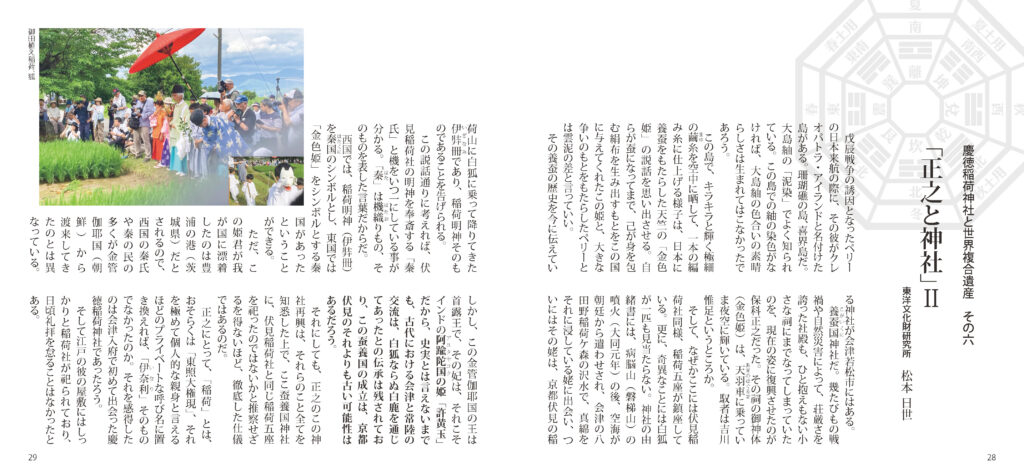Masayuki and the Shrine II

Keitoku Inari Shrine and World Heritage Site 6
When Perry sailed to Japan, which triggered the Boshin War, he named the island “Clepatra Island.” It is a coral reef island called Kikaijima.
It is well known for the “mud dyeing” of Oshima Tsumugi. Without the dyeing of Tsumugi on this island, the splendor of the colors of Oshima Tsumugi would not have been born.
The glittering, extremely fine cocoon threads are exposed to the air and turned into a single strand of yarn on this island reminds us of the legend of the “Golden Princess” of Tenjiku, who brought sericulture to Japan. This princess, who gave this country the source of silk cloth to cover herself, even by becoming a silkworm herself, is a world apart from Perry, who brought about a great conflict.
There is a shrine in Aizuwakamatsu City that still tells the history of sericulture.
It is Kogaikuni Shrine. Due to countless wars and natural disasters, the once magnificent shrine building had been reduced to a tiny altar barely big enough to hold a single arm. It was Hoshina Masayuki who restored it to its current appearance. The deity of the shrine (Konirohime) now shines in the night sky on a heavenly feathered chariot. The driver is likely Yoshikawa Koretari.
And for some reason, just like Fushimi Inari Shrine, the five Inari shrines are enshrined here. What’s more, strangely, there is not a single white fox to be seen. The shrine’s history book states that after the eruption of Byonouzan (Mt. Bandai) (in the first year of the Daido era), Kukai was sent by the Imperial Court to encounter an old woman soaking cotton wool in the stream water of Hatano Inari-ga-mori in Aizu, and was eventually told that the old woman was Izanami, who had descended on a white fox to Mount Inari in Fushimi, Kyoto, and was Inari Myojin himself.
If we follow this legend, we can see that the Hata clan, who worship the deity of Fushimi Inari Shrine, and looms are one and the same. That’s because “Hata” is a word that represents weaving machines themselves.
In the western part of Japan, the symbol of the Hata state was Inari Myojin (Izanami), while in the eastern part of Japan, the symbol of the state was the “Golden Princess.”
However, it is said that this princess washed ashore in Japan at the port of Toyoura (Ibaraki Prefecture), which is different from the fact that many of the Hata clan and people of the western part of Japan came from the country of Kinkan Gaya (Korea).
However, the king of this kingdom of Kinkan Gaya was King Suro, and his wife was none other than Princess Heo Hwang-ok from the kingdom of Ayutthaya in India. Although this cannot be said to be historical fact, there is a legend that the ancient exchange between Aizu and Hitachi was through a white deer, not a white fox, and it is possible that the establishment of this country of silkworms is older than that of Fushimi in Kyoto.
Even so, Masayuki’s restoration of this shrine is so thorough that one cannot help but assume that he knew all about all of this and enshrined the same five Inari shrines as Fushimi Inari Shrine here at Silkworm Country Shrine.
For Masayuki, “Inari” probably meant “Tosho Daigongen,” and if you replace that with a private name that could be said to be extremely personal and dear, it was “Inari” itself. It was probably Keitoku Inari Shrine, which he first encountered when he entered Aizu, that made him realize this. It is said that he had an Inari shrine enshrined in his Edo mansion and never neglected to worship at it.
